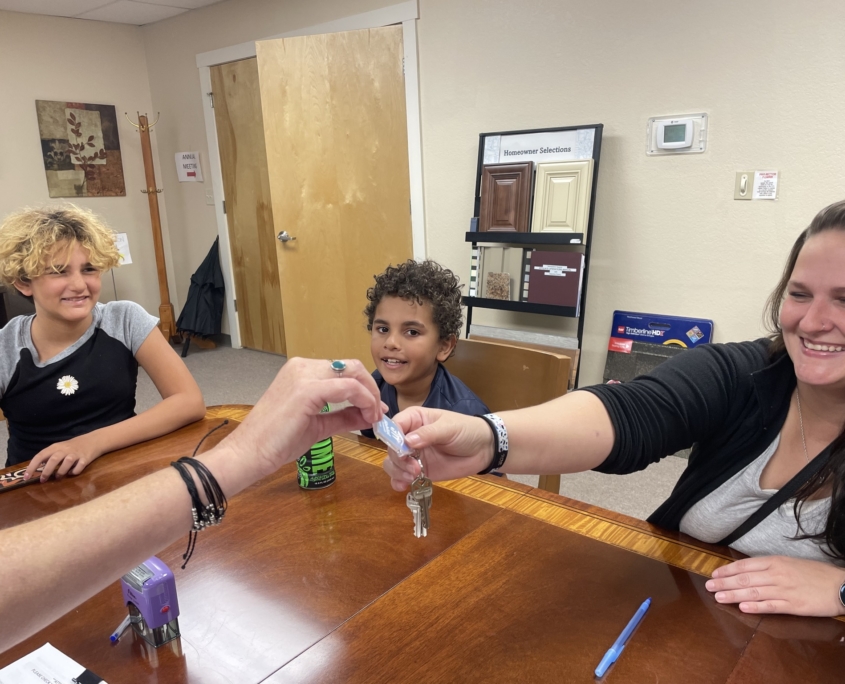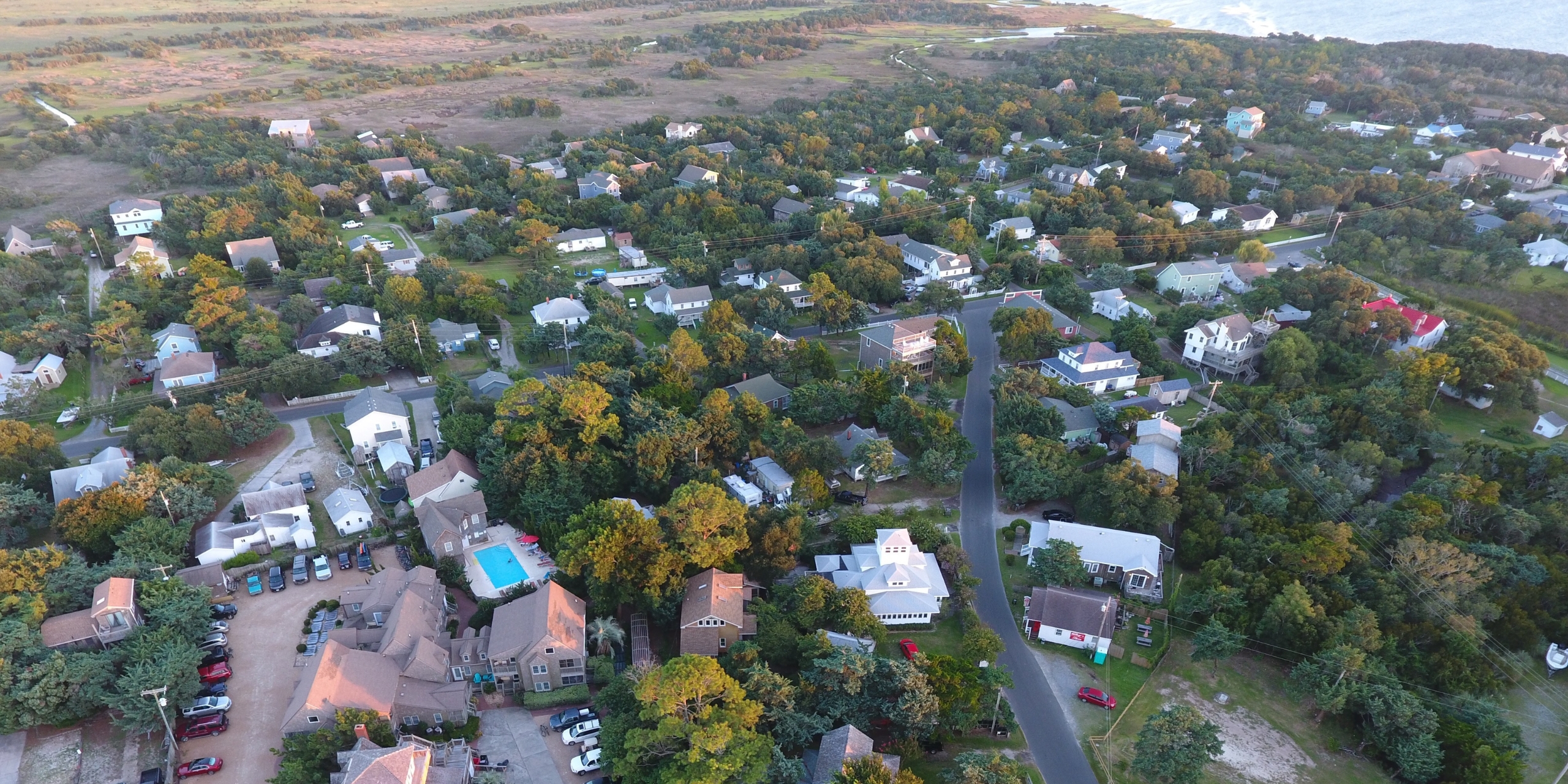by Ahmed Jallow, Carolina Public Press
When Hurricane Dorian hit the Outer Banks in early September 2019, Ocracoke, a small unbridged island in Hyde County, bore the brunt of the impact. The storm destroyed 40 homes and damaged hundreds more, leaving 400 of the island’s 1,000 residents homeless.
Long before Dorian hit, Ocracoke Island, known for its long sandy beaches and natural attractions, had been grappling with an affordable housing shortage for its almost 1,000 year-round residents. “It just became a crisis level,” said Sara Teaster who moved to the island 10 days after the hurricane.
The COVID-19 pandemic exacerbated the housing crisis on Ocracoke Island, a popular tourist destination, and the population can reach 10,000 people a day during peak season. Remote workers flooded the island, and property owners, some seeking to recoup storm repair expenses, converted year-round rentals into weekly ones.
This has left residents like Teaster, who’s been searching for a new rental for the past six months, struggling to find affordable housing. “It’s incredibly stressful,” said Teaster, whose landlord is moving back to the island. “I’m very embedded in this community and I don’t want to leave, but it’s very hard to find a place to live.”

Hurricane Dorian hit the Outer Banks as a Category 1 hurricane in September 2019, leaving homes uninhabitable and severe damage across Ocracoke Island. Photo: Sara Teaster
Mainland Hyde County faces similar struggles, including aging housing and limited rental options.
In the 2022 fiscal year, Habitat for Humanity local affiliates in North Carolina built 229 new homes and repaired 560, according to data provided by Habitat. None were in Hyde County, which is one of 24 counties in the state without a local affiliate.
Across North Carolina, there is a growing need for affordable housing models such as Habitat as home prices increase and incomes remain stagnant.
Could more Habitat for Humanity affiliates help?
Since opening its first North Carolina affiliate in Asheville in 1983, Habitat has built more than 8,000 new houses in the state, according to Habitat. North Carolina boasts the third-highest number of Habitat homes built in the U.S., behind Texas and Florida.
Habitat offers one of the few pathways to homeownership for families earning below 80% of the Area Median Income. For families at or below 50% of AMI, it is the only option.
Driving through the island, Teaster is frustrated by the vacant houses that line the streets, some gutted, others in need of repairs. “It’s really hard to drive past these vacant houses that … have been partially gutted or somewhat still need repairs, but maybe the owners don’t have the money to do it or … they don’t have the time or they don’t live here,” she said. “But if there was a community build group —like the way Habitat does— we could maybe get some of these houses fixed and put people in them.”
Ocracoke needs year-round housing for all essential workers, but the greatest need is for rents between $650 and $1,000 per month, according to a report last year from Development Finance Initiative, an arm of the University of North Carolina Chapel Hill’s School of Government. The median rent on the island is $1,100 per month, and median house sales are $445,000, according to the report.
Since the median household income for a family of four in Hyde County is $58,000, the report found that all Ocracoke essential workers earn less than 100% of the area median income.
The lack of large, contiguous land parcels in Ocracoke makes single-family homes a more practical option than multifamily structures like large apartment complexes. Habitat, with its experience in building such homes, could play a key role in addressing this housing need.
“I know part of Habitat’s model is to help people own their own homes,” said Teaster, who is also a member of Hyde County Educational Foundation, a new nonprofit that is constructing six affordable housing units for new Hyde County School teachers. “Owning a home is very important to establishing long-term community members, so you don’t get transient population. How do you have someone that’s invested in the community? Homeownership is a big part of that, and I know that’s how Habitat helps a lot of people.”
While groups like Habitat cannot alone address Hyde County’s shortage of affordable housing, they can play a crucial role in complementing other efforts including local government initiatives.
For now, the dream of homeownership feels increasingly out of reach for many like Teaster. “Homeownership, at least here on the island, is unattainable for someone like me,” Teaster said. “I have a good job. I have a good income, but it’s not enough to where I could buy a house.”

Heather Witt, alongside her two children, gets the keys to their new home. Photo: Transylvania Habitat for Humanity
‘I feel empowered’
Heather Witt applied for a home, though hesitantly, after learning on Facebook that the Transylvania Habitat for Humanity was accepting applications. She didn’t think she’d qualify.
Witt had been living in a two-bedroom government-subsidized apartment with her two kids in Brevard. They were growing up and she needed space.
But in September, she moved with her two children to a three-bedroom house under an agreement with Transylvania Habitat for Humanity that requires Witt to make monthly house payments capped at 30% of her income (approximately $1,080) and contribute a total of 200 hours of “sweat equity.”
“It feels amazing, and I feel empowered that this is mine,” said Witt, who volunteered at the organization’s ReStore thrift outlet. “I can paint the walls whatever color I want for my kids, and I can write little notches from where they’re growing every couple of months on my wall. I can plant whatever I want. It’s empowering, it’s freeing.”

Heather Witt’s new three-bedroom house is one of Transylvania Habitat for Humanity’s 77 homes completed since its founding in 1984. Photo: Transylvania Habitat for Humanity
This year, Transylvania Habitat for Humanity is poised to complete its 77th home since its founding in 1984. Historically, the organization, which is based in Brevard, built one or two homes annually, but production increased to four homes in 2022 and five homes in 2023.
“It’s such a huge problem that there is no way we could build enough homes to fill the gap completely,” said Angie Hunter, who has served as the organization’s executive director since October 2019.
In Transylvania County, 22% or 3,046, households are cost-burdened, according to North Carolina Housing Coalition— 41% are renters and 18% are homeowners.
About 800 low-to-moderate-income Transylvania families are in need of housing, according to a July report from DFI. Nearly half of Transylvania’s workforce is employed in industries such as retail, earning an average of less than $40,000 per year, according to the report.
The median price of a newly constructed single-family home more than doubled between 2016 and 2022, reaching $633,000. In July 2021, a household needed to earn $77,000 to afford a home in Transylvania County. Today, a household income of $133,000 is needed to afford a home, representing 170% of the area median income (AMI) for a family of four.
High housing costs in Brevard force many essential workers, including teachers, police officers, and home health aides, to commute in from outside the city. Over half of Brevard’s commuters, about 700 people, earn less than $40,000 annually, falling below 80% of the area median income. Many were once residents of Brevard who were forced out due to rising housing costs.
The organization’s new “critical home repair” program, launched this year, will help low- to moderate-income residents maintain their homes, and will expand the organization’s reach within the county. So far, they have completed 57 repairs, said Hunter.
Over the past few years, Transylvania Habitat for Humanity has grown its staff to 18, which has helped increase the number of houses it builds. “What we’re doing is trying to build our capacity to build more homes. We’ve increased our staff, our fundraising, and the number of clients. We couldn’t have ever done that type of production without growing our staff,” said Hunter.
The organization has recently acquired an 8.1-acre property near Brevard, where it plans to build 33 affordable homes.
“If asked what keeps me up at night, my response would be the speed in which we can build homes,” Hunter said. “We want to provide these families and individuals with housing solutions at a much faster pace because the crisis has never been more acute.”
Managing local Habitat affiliates
Establishing local Habitat affiliates is not without difficulties. Each affiliate operates independently, functioning as a construction company, retail store, mortgage underwriter and servicer.
All the original members of the Alexander Habitat for Humanity quit, soon after they hired Matt Cooksey in 2002 as the executive director of the organization.
“They did a good job, but they were exhausted afterward because they did most of the work themselves,” said Cooksey, whose organization has built 28 homes since 2002. They didn’t know how to do the fundraising and all other parts of it, so they ended up hiring me.”
For his first six years, Cooksey was the sole employee, managing all aspects of the organization without any support staff. Today, he leads a team of roughly five part-time employees on the Habitat side and 10 on the ReStore side.
Unlike larger affiliates, Cooksey often manages the entire process for applicants, from initial contact to closing the house. This includes financial paperwork, legal work and even construction. While some tasks are now delegated, like office administration and ReStore operations, he is still actively involved in construction alongside a small team.
As a rural affiliate, Cooksey said donations are hard to come by. In his 21 years, the largest donation his affiliate has received is $1,500, a stark contrast to millions received by some urban counterparts. Part of the reason, Cooksey said, is that large corporations tend to be located in urban areas. This past February, Bank of America, Lowe’s, and Wells Fargo donated $1 million each to Habitat Charlotte Region to help celebrate its 40th anniversary and support the Jimmy & Rosalynn Carter Work Project. The bank also has a team of volunteers who participate in Habitat Charlotte Region’s homebuilding projects.
“If you’re a company, are you going to be headquartered in a small rural county or are you going to be in a big urban area,” asked Cooksey. “Most of the time they give money where their headquarters is and so we don’t get that here.”
In Alexander County, which is just north of Hickory, 17% of households struggle with housing costs, with renters accounting for 33% and homeowners 14%, according to a North Carolina Housing report. This statistic is a constant reminder of the challenge ahead, said Cooksey, noting the increased demand for Habitat houses.
On a recent Saturday, Cooksey was hanging a drywall with a group of high school students from a nearby school. “This house we just were working on I laid all the corners myself and then high school kids came in and they did the rest of it.”
This story is part of ‘I Can’t Afford to Live Here,’ a collaborative reporting project focused on solutions to the affordable housing crisis in Charlotte.
Carolina Public Press is part of the Charlotte Journalism Collaborative (CJC), launched by the Solutions Journalism Network with funding from the Knight Foundation. The CJC strengthens the local news ecosystem and increases opportunities for engagement. It is supported by a combination of local and national grants and sponsorships. For more information, visit charlottejournalism.org.




